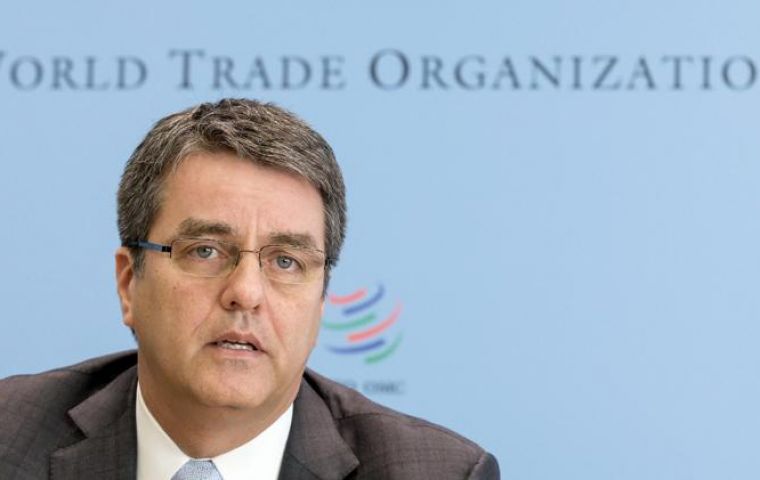MercoPress. South Atlantic News Agency
World trade expected to grow 4.7% this year and 5.3% in 2015, says WTO
 WTO Director-General Azevêdo said. “It's clear that trade is going to improve as the world economy improves”.
WTO Director-General Azevêdo said. “It's clear that trade is going to improve as the world economy improves”. World trade is expected to grow by a modest 4.7% in 2014 and at a slightly faster rate of 5.3% in 2015 World Trade Organization economists announced on Monday. The 4.7% forecast is more than double the 2.1% increase of last year, but remains below the 20-year average of 5.3%. For the past two years, growth has averaged only 2.2%.
The sluggish pace of trade growth in 2013 was due to a combination of flat import demand in developed economies ( 0.2%) and moderate import growth in developing economies1 (4.4%). On the export side, both developed and developing economies only managed to record small, positive increases (1.5% for developed economies, 3.3% for developing economies).
“For the last two years trade growth has been sluggish. Looking ahead, if GDP forecasts hold true, we expect a broad-based but modest upturn in 2014, and further consolidation of this growth in 2015”, WTO Director-General Roberto Azevêdo said. “It's clear that trade is going to improve as the world economy improves. But I know that just waiting for an automatic increase in trade will not be enough for WTO Members.”
“We can actively support trade growth by updating the rules and reaching new trade agreements. The deal in Bali last December illustrates this.”
“Concluding the Doha round would provide a strong foundation for trade in the future, and a powerful stimulus in today’s slow growth environment. We are currently discussing new ideas and new approaches which would help us to get the job done — and to do it quickly.”
Several factors contributed to the weakness of trade and output in 2013, including the lingering impact of the EU recession, high unemployment in Euro area economies (Germany being a notable exception), and uncertainty about the timing of the Federal Reserve’s winding down of its monetary stimulus in the United States. The latter contributed to financial volatility in developing economies in the second half of 2013, particularly in certain “emerging” economies with large current account imbalances.
The preliminary estimate of 2.1% for world trade growth in 2013 refers to the average of merchandise exports and imports in volume terms, i.e. adjusted to account for differences in inflation and exchange rates across countries. This figure is slightly lower than the WTO’s most recent forecast of 2.5% for 2013, issued last September. The main reason for the divergence was a stronger than expected decline in developing economies’ trade flows in the second half of last year. For the second consecutive year, world trade has grown at roughly the same rate as world GDP at market exchange rates, rather than twice as fast, as is normally the case.
Recent business surveys and industrial production data point to a firming up of the recovery in the United States and Europe in early 2014. The gradual improvement of US employment data has allowed the Federal Reserve to proceed with its planned “tapering”, of their third round of quantitative easing (“QE3”) The outlook for the European Union has also improved, although growth there will remain uneven as long as peripheral EU economies continue to underperform core ones. Output growth in Japan should be slightly lower this year as planned fiscal consolidation is implemented. Finally, despite having hit a soft patch recently, developing economies (including China) should continue to outpace developed economies in terms of GDP and trade growth in the coming year, but some could encounter setbacks, particularly those most exposed to the recalibration of monetary policy in developed countries.
In 2013, the dollar value of world merchandise exports rose 2.1% to 18.8 trillion. This growth rate was slightly less than the WTO’s export volume growth estimate for the year (+2.4%), which implies that export prices declined slightly from one year to the next. Meanwhile, the value of world commercial services exports rose 5.5% to $4.6 trillion.




Top Comments
Disclaimer & comment rules-

Read all comments“For the past two years, growth has averaged only 2.2%.”
Apr 14th, 2014 - 06:50 pm 0But we are to believe it will be 4.7%.
The Liar Mantega hasn’t had a hand in this has he; it looks like his type of forecast?
We will see.
Commenting for this story is now closed.
If you have a Facebook account, become a fan and comment on our Facebook Page!